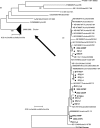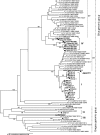Molecular epidemiology of echoviruses 11 and 13, based on an environmental surveillance conducted in Toyama Prefecture, 2002-2003
- PMID: 16957267
- PMCID: PMC1563678
- DOI: 10.1128/AEM.02621-05
Molecular epidemiology of echoviruses 11 and 13, based on an environmental surveillance conducted in Toyama Prefecture, 2002-2003
Abstract
Nineteen echovirus 11 (E11) and 12 E13 isolates were isolated from three rivers in Toyama Prefecture, Japan, during an environmental surveillance conducted from April 2002 to March 2003. The nucleotide sequences of E13 isolates were closely related to those from patients with aseptic meningitis, with less than 1.3% divergence in the VP1 region of the viral capsid gene, and belonged to the same clade responsible for a worldwide outbreak that started in 2000. In contrast, E11 isolates were clustered into three genomic groups and were not closely related to echovirus strains isolated from patients. These results suggest that the combination of both virus isolation from environmental sources and phylogenetic analysis could be complementary assessment approaches to trace prevalent and minor circulating enteroviruses in the human population.
Figures




Similar articles
-
Molecular phylogeny of VP1, 2A, and 2B genes of echovirus isolates: epidemiological linkage and observations on genetic variation.Arch Virol. 2006 Jun;151(6):1117-32. doi: 10.1007/s00705-005-0697-4. Epub 2006 Jan 26. Arch Virol. 2006. PMID: 16437188
-
Recent outbreak of aseptic meningitis in Italy due to Echovirus 30 and phylogenetic relationship with other European circulating strains.J Clin Virol. 2013 Nov;58(3):579-83. doi: 10.1016/j.jcv.2013.08.023. Epub 2013 Aug 31. J Clin Virol. 2013. PMID: 24051044
-
Molecular characterization of echovirus 30-associated outbreak of aseptic meningitis in Guangdong in 2012.Virol J. 2013 Aug 23;10:263. doi: 10.1186/1743-422X-10-263. Virol J. 2013. PMID: 23968330 Free PMC article.
-
FDJS03 isolates causing an outbreak of aseptic meningitis in China that evolved from a distinct Echovirus 30 lineage imported from countries of the Commonwealth of Independent States.J Clin Microbiol. 2006 Nov;44(11):4142-8. doi: 10.1128/JCM.01049-06. Epub 2006 Sep 6. J Clin Microbiol. 2006. PMID: 16957029 Free PMC article.
-
Parechoviruses.J Virol. 1999 Jul;73(7):5249-54. doi: 10.1128/JVI.73.7.5249-5254.1999. J Virol. 1999. PMID: 10364270 Free PMC article. Review. No abstract available.
Cited by
-
Prevalence of Non-Polio Enteroviruses in the Sewage of Guangzhou City, China, from 2013 to 2021.Microbiol Spectr. 2023 Jun 15;11(3):e0363222. doi: 10.1128/spectrum.03632-22. Epub 2023 Mar 30. Microbiol Spectr. 2023. PMID: 36995241 Free PMC article.
-
Monitoring Enteroviruses and SARS-CoV-2 in Wastewater Using the Polio Environmental Surveillance System in Japan.Appl Environ Microbiol. 2023 Apr 26;89(4):e0185322. doi: 10.1128/aem.01853-22. Epub 2023 Mar 28. Appl Environ Microbiol. 2023. PMID: 36975804 Free PMC article.
-
CaFÉ: A Sensitive, Low-Cost Filtration Method for Detecting Polioviruses and Other Enteroviruses in Residual Waters.Front Environ Sci. 2022 Jul 4;10:10.3389/fenvs.2022.914387. doi: 10.3389/fenvs.2022.914387. Front Environ Sci. 2022. PMID: 35928599 Free PMC article.
-
Genetic characterization of a novel recombinant echovirus 30 strain causing a regional epidemic of aseptic meningitis in Hokkaido, Japan, 2017.Arch Virol. 2020 Feb;165(2):433-438. doi: 10.1007/s00705-019-04484-7. Epub 2019 Dec 11. Arch Virol. 2020. PMID: 31828510 Free PMC article.
-
Environmental Surveillance Can Dynamically Track Ecological Changes in Enteroviruses.Appl Environ Microbiol. 2019 Nov 27;85(24):e01604-19. doi: 10.1128/AEM.01604-19. Print 2019 Dec 15. Appl Environ Microbiol. 2019. PMID: 31585989 Free PMC article.
References
-
- CDC. 2001. Echovirus type 13—United States, 2001. Morb. Mortal. Wkly. Rep. 50:777-780. - PubMed
-
- CDR. 2000. Viral meningitis associated with increase in echovirus type 13. Commun. Dis. Rep. CDR Wkly. 10:277, 280. - PubMed
-
- Cheon, D. S., J. Lee, K. Lee, S. Lee, K. Park, J. Ahn, Y. Jee, J. Yoon, and H. Cho. 2004. Isolation and molecular identification of echovirus 13 isolated from patients of aseptic meningitis in Korea, 2002. J. Med. Virol. 73:439-442. - PubMed
Publication types
MeSH terms
Substances
Associated data
- Actions
- Actions
- Actions
- Actions
- Actions
- Actions
- Actions
- Actions
- Actions
- Actions
- Actions
- Actions
- Actions
- Actions
- Actions
- Actions
- Actions
- Actions
- Actions
- Actions
- Actions
- Actions
- Actions
- Actions
- Actions
- Actions
- Actions
- Actions
- Actions
- Actions
- Actions
- Actions
- Actions
- Actions
- Actions
- Actions
- Actions
- Actions
- Actions
- Actions
- Actions
- Actions
- Actions
- Actions
LinkOut - more resources
Full Text Sources
Miscellaneous

